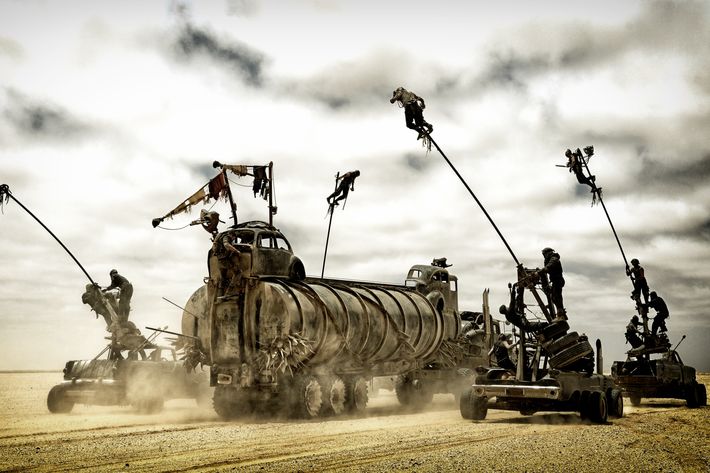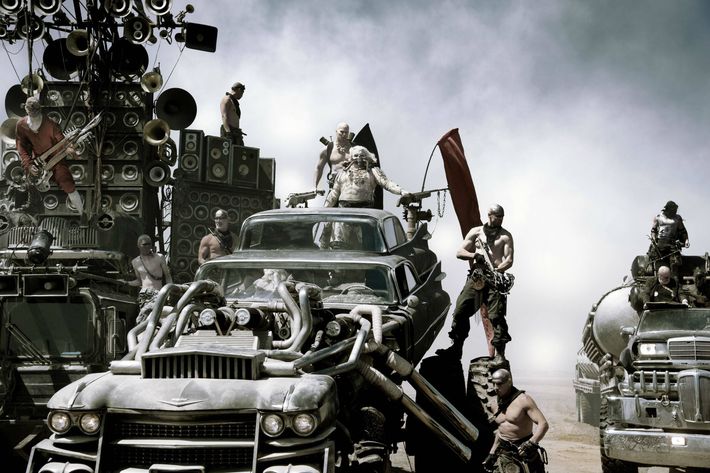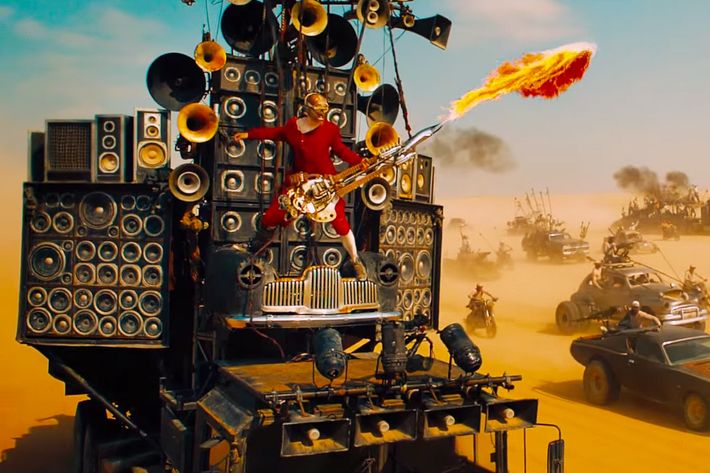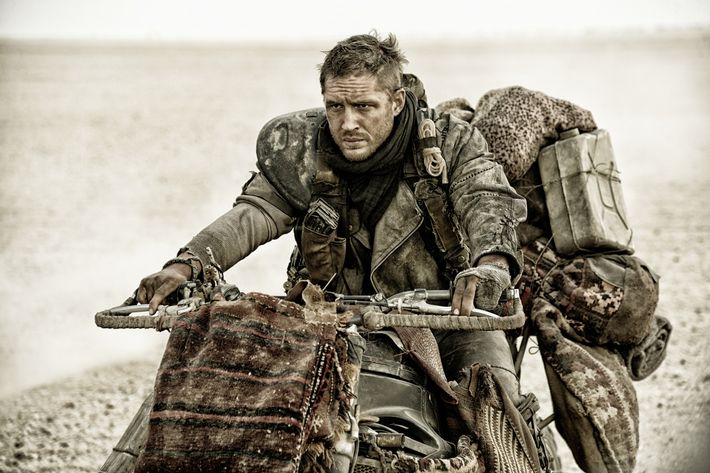
When you make a movie that’s essentially one long car chase, you’re going to need a production designer who knows cars. On Mad Max: Fury Road, that job fell to Colin Gibson, who worked with director George Miller on creating the film’s fleet of post-apocalyptic war chariots. Gibson spoke with John Horn, host of Southern California Public Radio’s arts and entertainment show “The Frame,” about creating cars for practical effects, the rules of Mad Max’s dystopian world, and why the film includes a heavy-metal guitarist who rides a truck full of amps. (Listen to part of Horn and Gibson’s interview below and subscribe to “The Frame” at iTunes or Stitcher.)
Unlike so many movies that are made today where everything was created in a computer, a lot of these stunts were going to be practical. How does that effect the design of the vehicles?
I was with the director [George Miller] on that. He had spent far too many years with pixels that did anything he wanted: tap-dancing penguins and pigs whose lips moved. So, this was a new and exciting experience to go back to his roots. We wanted to make it the last real action film and to do the stunts as real as possible, and we designed all of that into the vehicles as we went. The problem with George is that apart from being a man of immense imagination, he unfortunately is also a certified doctor, and so he had signed the Hippocratic oath, which means he’s not supposed to go out and hurt anybody on purpose. It was a little antithetical to the idea of 300 stunts at high speed. Each of the vehicles was designed with safety in mind, but also with each and every one of their specific stunts, their deaths, their character arcs, built into the design, into the very DNA of how they were put together. The art department worked with the stunt department and with the mechanical-special-effects department to ensure that we had the best unit possible that could do what it needed to do to get airborne at 80 [kilometers] an hour, to spin through the air, to deposit its load safely but spectacularly.
One of the things that’s clear in this movie is that everything is recycled. What is new is old again or what is old is new again, that everything is a composite of new and recycled parts, that everything gets repurposed. So you have to create basically a narrative for every piece of machinery in this movie.
Not just their backstory, all the objects became a fetish. One of the things that we wanted to do was to not treat anything. There’s been a lot of degraded use of the idea of the apocalypse. Anybody thinks you can weld a piece of barbed wire to a Camaro and my God, it’s the future. What we wanted to do was to build up a stockpile of things that had inherent interest or beauty and that we could then take out of context and reuse. There’s the story-line requirements for the film itself and then there’s the character, the life that that object, car, weapon, fetish has to have. And so we found things that we thought were beautiful enough to salvage, or at least to tickle at some futuristic, apocalyptic, “I wonder what that was, what did they use it for, and now I’m going to repurpose it for war, for battle, for thirst, for the end of the universe” feeling. All that flotsam and jetsam that had washed up at the end of the world, we just put it to new and slightly brutal use.
And this is a conversation you’re having with your costume designer, with your props designer, it is the entire universe in which this story unfolds.
Absolutely. Everything was of a piece and the first thing we did was design the design process, and so we designed everything the way they would’ve come to it. We went out, we found things that were beautiful in and of themselves, now whether that’s the curve of a sprayless air gun or a Hills Hoist or a small jackhammer, but we’d repurpose them, see things anew, and take them out of context so that they had a new life.
So, does this mean that if the apocalypse were to really happen, I should come to you because you know how to get us through it?
Well, you can come to me and I’ll put you on to a couple of good mechanics. We did tell the Burning Man people, for when the apocalypse does come, I think hiding in a concrete bunker with 64,000 cans of baked beans is far less exciting than going out and building a V-8 [engine].
I want to talk about Burning Man, because Burning Man is a kind of a cultural signpost but it’s also a design reference, it seems, in terms of things being built out of found objects in the desert.
I visited a lot of deserts and Burning Man was one of them. A lot of the people who worked for me in Africa, their next job after we finished was indeed going to Burning Man, stealing whatever was leftover from our pile of salvage, and turning it into something fantastic, and I believe they all had a glorious time exploding things.
So, when you left Africa, was everything basically in bits and pieces? Were there cars you could sell off, or was everything pretty much ruined?
There was no sell-off involved. There’s some ridiculous insurance problem trying to get registration on some of those vehicles that are, you know, three-and-a-half meters off the ground and powered by three, sometimes four, engines.

Let’s talk about the War Rig. I want to talk about the component on the back of this vehicle, it looks like the shell of a Volkswagen Beetle, am I right there?
Yeah, it is, the War Rig is somewhere between an 18-wheel leviathan and a hot rod, and I tried to give it both of the above. And yet George had also given it quite a lot of crew. As it was the main barter vehicle out in the wasteland, it needed to have its own defense unit and that defense unit needed gun turrets, and so given that we’re a car-based society, the choice bombardier turret at the far end of the tanker was a Volkswagen.
Some people today might decorate their cars with certain decals or paint jobs. This is decorated with some skulls, so there’s a lot of kind of violent imagery that’s decorative.
If you look closer, some of those are skulls, some of those are animal, some of them are human, they’re there again as a fetish, as a “beware.” If you look closer, they’re also mixed with the heads of baby dolls, things that have no context anymore but appear to be humanlike. That was one of those [things that had] the tribes scratching their heads and saying, What is this strange thing, love?
Your imagination is incredibly active, but one of the things that you have to do as a designer is these vehicles have to operate. They don’t just look good or look menacing, they actually have to drive. Were there instances where you and your team created cars or vehicles that looked fantastic but were too heavy to actually move down the road?
Never. I embrace physics and that was one of the things that we loved about this. The design was not to come up with something, because the design process was to design them the way they would take salvage, put it together, fetishize it, and give it the most power it could possibly have because you are then sending it off to do glorious battle in the wasteland.

I want to talk now about a vehicle that plays a prominent role called the Gigahorse. It looks like a couple of Cadillac coupe de Villes have gone out and had a secret mating ritual.
Yeah, that was always the theory. I remember telling a few people it was meant to be a pair of 1959 Cadillac Coupe de Villes in flagrante delicto. And fortunately nobody speaks Latin anymore, so I’ve got away with it in quite a few places.
Certain people who are familiar with the series of films would say, “Where is the Mad Max Interceptor?” I think you tip your hat to them very quickly and then say, “We’re done with that.”
We’re passing the baton. The phantom and many of his children who all manage to fit into the same purple suit, we pass the baton to Tom Hardy as the new Max, but the baton itself had to be the legend, the 1974 FXP4 GTO3 50 Interceptor. So we do open with that baton, which then goes into a spectacular crash, and it does actually make a comeback — this is a recycled universe that we live in so nothing goes to waste — and it comes back jacked up on a new off-road set of wheels, tires, new suspension, new Chevy, double aspirated and weaponized to hell. And Max is forced to do battle with his own past.

I want to talk now about my favorite vehicle in the whole movie, what you call the Doof Mobile, am I pronouncing that correctly?
Yeah, Doof as in doof, doof, doof.
This is something that you would see most likely at a rock concert, it is an array of loudspeakers and spotlights. On the roof of this vehicle is a guitarist whose guitar shoots flames. This vehicle is insane. How did it come to be?
George figured that every army has a little drummer boy, and his little drummer boy was required to be slightly louder to be heard over 150 V-8s, V-12s, W-16s, etc. And so it became Spinal Tap on wheels, with everything turned up to 11. We took an eight-wheel-drive rocket-launcher truck, stripped it back, rebuilt it with steel air-conditioning ducting from the insides of a couple of large buildings, turned that into the reverberating drums of the Tycho drummers on the rear, and then the last Marshall stack before hell screwed to the front of the unit.

And we should also talk about the motorcycles that a group of women of a certain age ride. What was the design concept for their bikes?
We had a lot of bikes and Yamaha supplied a lot of bikes for us kindly, which we unfortunately stripped down to component parts and made them almost unrecognizable. But the Vuvalini, the biker women at the last sand dune before the end of the universe, their bikes were more fully formed out of history. Rather than completely rebuilt and remade, they were repurposed to a Bedouin, if slightly manslaughter-minded existence. There was a Royal Enfield and a side-car set-up, there was a gull-wing, a couple of different BMW units, an old Harley, and a Yamaha R-1,000 that were basically all stretched, extended, and turned into camels of our new desert.
If we look into the future, it’s clear that the Camry and the Prius have very little appeal. They’re certain cars that if you drive around the United States you’d see all the time. You seem to have very little interest in their future after the apocalypse.
We had three main reasons for keeping things alive. George said everything had to earn its right to exist in our universe, and frankly carbon-fiber bodies don’t lend themselves to battle so well. The computer chip makes almost all modern vehicles fairly useless, whereas a decent grunt-y V-8 you can fix with a stick and a torn pair of pantyhose, and thirdly, I can’t see anybody going to the trouble of schlepping a Camry halfway across the wasteland and salvaging it, so it didn’t pass the “beauty’ process” — which is not to say that come a prequel or sequel, the Prius won’t make a proud entrance.
You spent 15 years thinking about the design of this movie. Many years building and designing these cars, and then you blow them all up. As a parent of these vehicles, is it a little bit sad to see them come to a violent and horrible end?
Absolutely not. That’s what they were designed for, and to bring that to fruition, to watch the huge explosion that took out the people-eaters’ horizontal fracking tower as it hurtled across the desert, made it all worthwhile.

